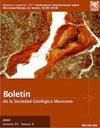哥伦比亚Tequendama和Aguazuque考古遗址全新世早期和中期的环境变化
IF 0.4
4区 地球科学
Q4 GEOLOGY
引用次数: 0
摘要
本研究的重点是确定两个考古遗址在占领期间可能的环境变化和植物可用性:位于哥伦比亚萨巴纳德波哥大本文章由计算机程序翻译,如有差异,请以英文原文为准。
Environmental variation in the early and middle Holocene Tequendama and Aguazuque archaeological sites, Colombia
This study focuses on identifying possible environmental variations and plant availability during the occupation in two archaeological sites: Tequendama and Aguazuque, located in Sabana de Bogotá, Colombia. Those sites represent periods of occupation during the early to middle Holocene that contributes valuable information about hunter-gatherers who occupied this area. Data obtained and recovered archaeological material during excavations shed light on relatively continuous occupations until the late Holocene. The presence of lithic artefacts, human and fauna bone remains offered relevant information to comprehend social dynamics among these human groups; likewise, phytolith and stable isotope analysis on sediments and fauna were carried out to identify environmental variations, and the presence of plant remains in these archaeological contexts. Carbon isotope analysis in sediments indicated the prevalence of plants C3 from the early Holocene. In turn, isotopic relationships in carbon obtained from mammals’ dental enamel found in both sites suggest that those animals consumed such types of plants. Also, isotopic values in oxygen from dental enamel show humid and possibly cold environmental conditions in both locations. Also, phytolith analyses provide evidence on the types of plants available in determined contexts and reconstruct environments, use, and availability. Those three types of analysis were applied to archaeological contexts to determine the presence of plants type C3 or C4 available in the sites, which permitted to evidence of environmental changes, humid conditions, and, in a few cases, drought across occupation, as well as the differences in terms of the presence or absence of certain types of plants during chronological periods, suggesting a possible association of horticultural processes and domestication during middle Holocene in Aguazuque archaeological site.
求助全文
通过发布文献求助,成功后即可免费获取论文全文。
去求助
来源期刊
CiteScore
1.40
自引率
12.50%
发文量
34
审稿时长
50 weeks
期刊介绍:
The Boletín de la Sociedad Geológica Mexicana is a completely free-access electronic journal published semi-annually that publishes papers and technical notes with its main objective to contribute to an understanding of the geology of Mexico, of its neighbor areas, and of geologically similar areas anywhere on Earth’s crust. Geology has no boundaries so we may publish papers on any area of knowledge that is interesting to our readers.
We also favor the publication of papers on relatively unfamiliar subjects and objectives in mainstream journals, e.g., papers devoted to new methodologies or their improvement, and areas of knowledge that in the past had relatively little attention paid them in Mexican journals, such as urban geology, water management, environmental geology, and ore deposits, among others. Mexico is a land of volcanos, earthquakes, vast resources in minerals and petroleum, and a shortage of water. Consequently, these topics should certainly be of major interest to our readers, our Society, and society in general. Furthermore, the Boletín has been published since 1904; that makes it one of the oldest scientific journals currently active in Mexico and, most notably, its entire contents, from the first issue on, are available online.

 求助内容:
求助内容: 应助结果提醒方式:
应助结果提醒方式:


